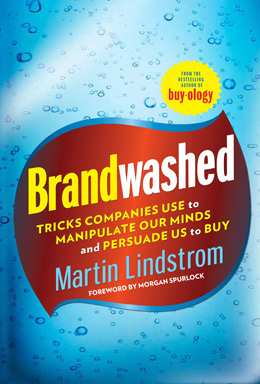 Most people believe they are media-savvy. We assume that advertisers and marketers use some, shall we say, "creative" ways to get us to buy the products they're selling, but we like to think that we don't fall for their tricks. Except that we do. It's not like we have much choice. These companies are just that good.And in the fascinating book Brandwashed, marketing insider Martin Lindstrom reveals how they do it.
Most people believe they are media-savvy. We assume that advertisers and marketers use some, shall we say, "creative" ways to get us to buy the products they're selling, but we like to think that we don't fall for their tricks. Except that we do. It's not like we have much choice. These companies are just that good.And in the fascinating book Brandwashed, marketing insider Martin Lindstrom reveals how they do it.The pitch begins at conception. Researchers have found that infants can remember advertising jingles and be drawn to the taste of certain foods that they were exposed to in the womb. By 18 months, children can recognize brands. Advertisers know this so they create simple jingles and cartoon mascots to program kids to favor a particular brand.
From there, marketers have us hooked. They employ imperceptible, emotional appeals using anything from fear to sex to nostalgia to spirituality. We buy hand sanitizer, scented body wash, vintage-styled clothing and goji berry yogurt because companies have convinced us that they will protect us from bacteria, attract the opposite sex, make us seem younger and keep us as healthy as a Buddhist monk, even though intellectually we know this can't be true.
And on top of that, the latest data mining technology allows companies to quietly glean information from social media profiles, web-surfing histories, smartphone records and retail loyalty cards to craft a detailed picture of not only what we are most likely to be interested in purchasing, but what kind of person we are, right down to our marital status and sexual orientation. The watchful eye of the marketer is all-knowing and virtually inescapable.
After reading Brandwashed, you may never look at an advertisement, marketing pitch or product the same way, but by understanding the methods used to influence our buying decisions, we can avoid falling victim to the tricks and manipulations. Then again, you'll still probably want the occasional Coke.
